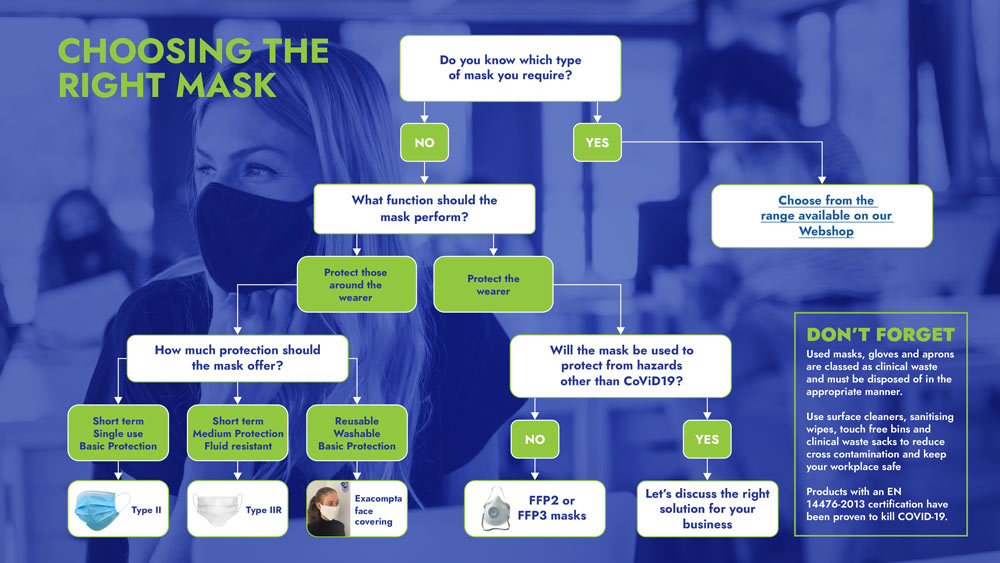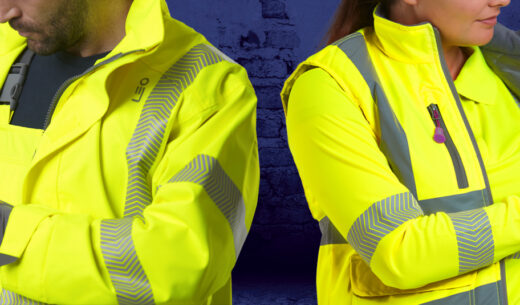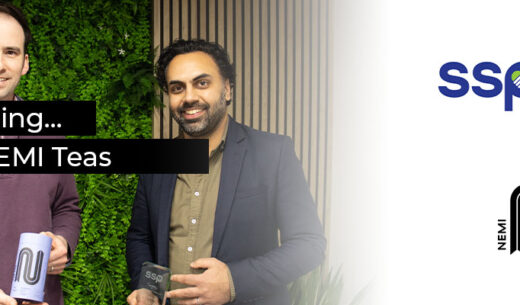Everything you need to know when choosing the right mask
*Updated on 22nd September 2020*
As government guidance once again changes across the four devolved nations of the United Kingdom and in the Republic of Ireland it’s important to know which type of masks & face-coverings we need to be wearing and in which settings. Preventing the spread of COVID-19 is paramount in the workplace, the health and safety of your employees should be your top priority and providing them with the correct mask or PPE is a step in the right direction. To check the most up-to-date guidelines on the Coronavirus outbreak visit the government website here.
With a wide variety of masks, respirators and face coverings to choose from, understanding the correct usage is important in order to provide the correct protection for yourself and your teams.

Type II Masks
Type II masks are loose-fitting Non Woven masks that create a physical barrier between the user’s nose/mouth and contaminants.
They prevent the user from contaminating others or surfaces with their respiratory droplets. However, please be aware that this style of mask is not designed to create a seal between the face and the mask, so there is still a risk of inhaling small particle aerosols and droplets carrying viruses.
They’re most effective when in environments with no risk of contact with blood and/or body fluid and unlikely exposure to viruses. For more information on our range of masks available, visit our Webshop
How to fit a Type II Mask:
The edges of the mask are not designed to seal fully around the nose and mouth, as they are loose-fitting, however, they must be fitted as closely as possible using the ties/straps. Donning and doffing protocols should be observed.
Healthcare sector:
Type II masks can be used in some low-risk clinical applications that do not involve blood-borne pathogens or bodily fluids to:
- Enhance infection control
- Prevent the risk of cross-contamination
Industrial sector:
Not currently recommended, however they may be considered in environments that involve physical proximity to many other people.
Community settings:
Recommended by the Government for general use in enclosed public spaces, such as
- Public transport
- Supermarkets
- Shopping centres
- Staff working in pubs and restaurants
- When working in retail or other hospitality settings
- Taxis
See gov.uk about the use of masks in community settings.
Type IIR Masks

Type IIR masks are loose-fitting woven masks that create a physical barrier between the user’s nose/mouth and contaminants.
This type of mask is not designed to create a seal between the face and the mask, so there is still a risk of inhaling small particle aerosols and droplets carrying viruses. They are splash resistant, however, and can protect the user against large droplets or sprays of hazardous fluids. They also prevent the user from contaminating others or surfaces with their respiratory droplets. For more information on our range of masks available, visit our Webshop
How to fit Type IIR Masks:
The edges of the mask are not designed to seal fully around the nose and mouth, as they are loose-fitting, however, they must be fitted as closely as possible using the ties/straps. Donning and doffing protocols should be observed.
Healthcare sector:
Type IIR masks are single-use in specific clinical care settings or exposure environments such as:
- In cohorted areas (but no patient contact)
- Close patient contact (within 1 meter)
Industrial sector:
Can be used by those potentially in close proximity to Covid-19, such as:
- Prison officers
- Police
- Security roles
Community settings:
Type IIR masks offer a higher level of protection to the wearer, so they are primarily intended for healthcare workers, other medical first aid responders and those in close contact with COVID-19. However, if there is sufficient supply, Type IIR masks may be used by the general public
Respirator Masks
Respirator masks, also known as Filtering Face Piece masks, are classified as FFP1, FFP2 or FFP3. This style of mask creates a seal between the face and the mask, effectively filtering and reducing the risk of inhaling hazardous airborne particles and droplets. For more information on our range of masks available, visit our Webshop
How to fit Respirator Masks:
These masks fit closely to the face and a user seal check is required each time the respirator is put on. Face fit testing remains a legal requirement in the UK. Wherever possible you must carry out a face fit test with a registered Fit 2 Fit accredited fit test provider – whenever a mask brand / model is used or changed. Users must be clean shaven.
For more information click here. Donning and doffing protocols should be observed.
Healthcare sector:
Due to the higher level of protection given by respirators, they can be used:
- When carrying out aerosol-generating procedures (AGP) on a patient with possible or confirmed COVID-19
- In high-risk areas where AGP’s are being conducted
Industrial sector:
They are to be used in environments where a risk assessment has identified a hazardous substance but no reduction in Oxygen level and specified the use of FFP1, FFP2 or FFP3 respiratory protection.
Community settings:
Due to the higher level of protection given by respirators, they are not recommended for the general public. They are critical supplies for healthcare workers, other medical first aid responders and those in close contact with COVID-19.
For more information on how to correctly fit your mask click here.
Make sure that you know the best way to remove face coverings and safely dispose of masks here
View our full range of masks here










